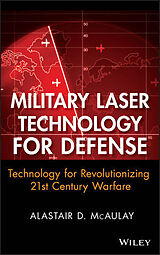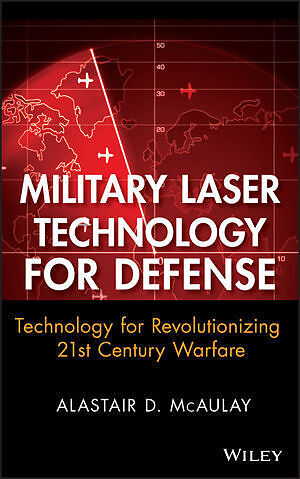Military Laser Technology for Defense
Einband:
Fester Einband
EAN:
9780470255605
Genre:
Electrical Engineering
Autor:
McAulay Alastair D.
Herausgeber:
John Wiley & Sons
Erscheinungsdatum:
13.05.2011
Lasers in War is the first book to collect and explain the laser system technologies used and proposed for the battlefield. It provides the basic knowledge to create, design, and implement a wide variety of laser systems for warfare, including only unclassified or declassified information.
Provided by publisher.
Autorentext
ALASTAIR D. McAULAY, PHD, is Professor of Electrical and Computer Engineering at Lehigh University.Previously he was NCR professor and chairman of the Department of Computer Science and Engineering at Wright State University and program manager in the Central Research Laboratories of Texas Instruments. He has published more than 150 papers and his book Optical Computer Architectures, published by Wiley in 1991, has been used for courses around the world and reprinted several times. Contact the author at www.linkedin.com/in/alastairmcaulay
Klappentext
Recent advances in ultra-high-power lasers, including the free-electron laser, and impressive airborne demonstrations of laser weapons systems, such as the airborne laser, have shown the enormous potential of laser technology to revolutionize 21st century warfare. Military Laser Technology for Defense, includes only unclassified or declassified information. The book focuses on military applications that involve propagation of light through the atmosphere and provides basic relevant background technology. It describes high-power lasers and masers, including the free-electron laser. Further, Military Laser Technology for Defense addresses how laser technology can effectively mitigate six of the most pressing military threats of the 21st century: attack by missiles, terrorists, chemical and biological weapons, as well as difficulty in imaging in bad weather and threats from directed beam weapons and future nuclear weapons. The author believes that laser technology will revolutionize warfare in the 21st century.
Inhalt
Preface xiii Acknowledgments xv About The Author xvii I Optics Technology for Defense Systems 1 1 Optical Rays 3 1.1 Paraxial Optics 4 1.2 Geometric or Ray Optics 5 1.2.1 Fermat's Principle 5 1.2.2 Fermat's Principle Proves Snell's Law for Refraction 5 1.2.3 Limits of Geometric Optics or Ray Theory 6 1.2.4 Fermat's Principle Derives Ray Equation 6 1.2.5 Useful Applications of the Ray Equation 8 1.2.6 Matrix Representation for Geometric Optics 9 1.3 Optics for Launching and Receiving Beams 10 1.3.1 Imaging with a Single Thin Lens 10 1.3.2 Beam Expanders 13 1.3.3 Beam Compressors 14 1.3.4 Telescopes 14 1.3.5 Microscopes 17 1.3.6 Spatial Filters 18 2 Gaussian Beams and Polarization 20 2.1 Gaussian Beams 20 2.1.1 Description of Gaussian Beams 21 2.1.2 Gaussian Beam with ABCD Law 24 2.1.3 Forming and Receiving Gaussian Beams with Lenses 26 2.2 Polarization 29 2.2.1 Wave Plates or Phase Retarders 31 2.2.2 Stokes Parameters 33 2.2.3 Poincaré Sphere 34 2.2.4 Finding Point on Poincaré Sphere and Elliptical Polarization from Stokes Parameters 35 2.2.5 Controlling Polarization 36 3 Optical Diffraction 38 3.1 Introduction to Diffraction 38 3.1.1 Description of Diffraction 39 3.1.2 Review of Fourier Transforms 40 3.2 Uncertainty Principle for Fourier Transforms 42 3.2.1 Uncertainty Principle for Fourier Transforms in Time 42 3.2.2 Uncertainty Principle for Fourier Transforms in Space 45 3.3 Scalar Diffraction 47 3.3.1 Preliminaries: Green's Function and Theorem 48 3.3.2 Field at a Point due to Field on a Boundary 48 3.3.3 Diffraction from an Aperture 50 3.3.4 Fresnel Approximation 51 3.3.5 Fraunhofer Approximation 54 3.3.6 Role of Numerical Computation 56 3.4 Diffraction-Limited Imaging 56 3.4.1 Intuitive Effect of Aperture in Imaging System 56 3.4.2 Computing the Diffraction Effect of a Lens Aperture on Imaging 57 4 Diffractive Optical Elements 61 4.1 Applications of DOEs 62 4.2 Diffraction Gratings 62 4.2.1 Bending Light with Diffraction Gratings and Grating Equation 63 4.2.2 Cosinusoidal Grating 64 4.2.3 Performance of Grating 66 4.3 Zone Plate Design and Simulation 67 4.3.1 Appearance and Focusing of Zone Plate 67 4.3.2 Zone Plate Computation for Design and Simulation 68 4.4 Gerchberg-Saxton Algorithm for Design of DOEs 73 4.4.1 Goal of Gerchberg-Saxton Algorithm 73 4.4.2 Inverse Problem for Diffractive Optical Elements 73 4.4.3 Gerchberg-Saxton Algorithm for Forward Computation 74 4.4.4 Gerchberg-Saxton Inverse Algorithm for Designing a Phase-Only Filter or DOE 74 5 Propagation and Compensation for Atmospheric Turbulence 77 5.1 Statistics Involved 78 5.1.1 Ergodicity 79 5.1.2 Locally Homogeneous Random Field Structure Function 80 5.1.3 Spatial Power Spectrum of Structure Function 80 5.2 Optical Turbulence in the Atmosphere 82 5.2.1 Kolmogorov's Energy Cascade Theory 83 5.2.2 Power Spectrum Models for Refractive Index in Optical Turbulence 85 5.2.3 Atmospheric Temporal Statistics 86 5.2.4 Long-Distance Turbulence Models 86 5.3 Adaptive Optics 86 5.3.1 Devices and Systems for Adaptive Optics 86 5.4 Computation of Laser Light Through Atmospheric Turbulence 89 5.4.1 Layered Model of Propagation Through Turbulent Atmosphere 90 5.4.2 Generation of Kolmogorov Phase Screens by the Spectral Method 92 5.4.3 Generation of Kolmogorov Phase Screens from Covariance Using Structure Functions 94 6 Optical Interferometers and Oscillators 99 6.1 Optical Interferometers 100 6.1.1 Michelson Interferometer 101 6.1.2 Mach-Zehnder Interferometer 105 6.1.3 Optical Fiber Sagnac Interferometer 108 6.2 Fabry-Perot Resonators 109 6.2.1 Fabry-Perot Principles and Equations 110 6.2.2 Fabry-Perot Equations 110 6.2.3 Piezoelectric Tuning of Fabry-Perot Tuners 116 6.3 Thin-Film Interferometric Filters and Dielectric Mirrors 116 6.3.1 Applications for Thin Films 117 6.3.2 Forward Computation Through Thin-Film Layers with Matrix Method 118 6.3.3 Inverse Problem of Computing Parameters for Layers 122 II Laser Technology for Defense Systems 125 7 Principles for Bound Electron State Lasers 127 7.1 Laser Generation of Bound Electron State Coherent Radiation 128 7.1.1 Advantages of Coherent Light from a Laser 128 7.1.2 Basic Light-Matter Interaction Theory for Generating Coherent Light 129 7.2 Semiconductor Laser Diodes 133 7.2.1 p-n Junction 133 7.2.2 Semiconductor Laser Diode Gain 136 7.2.3 Semiconductor Laser Dynamics 139 7.2.4 Semiconductor Arrays for High Power 140 7.3 Semiconductor Optical Amplifiers 140 8 Power Lasers 143 8.1 Characteristics 144 8.1.1 Wavelength 144 8.1.2 Beam Quality 144 8.1.3 Power 145 8.1.4 Methods of Pumping 146 8.1.5 Materials for Use with High-Power Lasers 147 8.2 Solid-State Lasers 148 8.2.1 Principles of Solid-State Lasers 148 8.2.2 Frequency Doubling in Solid State Lasers 150 8.3 Powerful Gas Lasers 158 8.3.1 Gas Dynamic Carbon Dioxide Power Lasers 158 8.3.2 COIL System 160 9 Pulsed High Peak Power Lasers 165 9.1 Situations in which Pulsed Lasers may be Preferable 165 9.2 Mode-Locked Lasers 167 9.2.1 Mode-Locking Lasers 167 9.2.2 Methods of Implementing Mode Lock…

Leider konnten wir für diesen Artikel keine Preise ermitteln ...
billigbuch.ch sucht jetzt für Sie die besten Angebote ...
Die aktuellen Verkaufspreise von 6 Onlineshops werden in Realtime abgefragt.
Sie können das gewünschte Produkt anschliessend direkt beim Anbieter Ihrer Wahl bestellen.
Loading...
Die aktuellen Verkaufspreise von 6 Onlineshops werden in Realtime abgefragt.
Sie können das gewünschte Produkt anschliessend direkt beim Anbieter Ihrer Wahl bestellen.
| # | Onlineshop | Preis CHF | Versand CHF | Total CHF | ||
|---|---|---|---|---|---|---|
| 1 | Seller | 0.00 | 0.00 | 0.00 |
